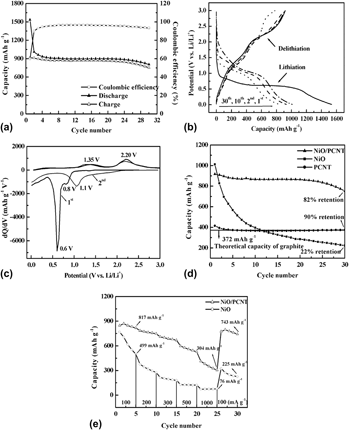Article contents
Ultrathin NiO nanoflakes perpendicularly oriented on carbon nanotubes as lithium ion battery anode
Published online by Cambridge University Press: 20 August 2013
Abstract

Core–shell nickel oxide/carbon nanotube (CNT) microwires, with interconnected nickel oxide nanoflakes (∼10 nm in thickness) vertically oriented on polymer-based CNTs, were synthesized by using low-cost starting materials and a scalable growth route. As revealed by morphological characterization, sheet–sheet and wire–wire interwoven of the composite constructed a porous structure. The composite as lithium ion battery anode exhibited high reversible capacity of 752 mAh/g at a current density of 100 mA/g over 30 cycles with 82% capacity retention. Even at high rate (1000 mA/g), the composite still delivered a high charge capacity (304 mAh/g) over 25 cycles. When the rate was reset to its initial value, 87.7% of the initial charge capacity was recovered. The composite showed remarkably enhanced performance compared to pure NiO, which was presumably due to the advantages of porous structure, oriented attachment, and attractive synergetic effect.
- Type
- Articles
- Information
- Copyright
- Copyright © Materials Research Society 2013
References
REFERENCES
- 7
- Cited by




